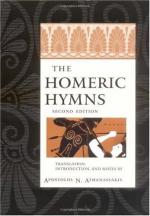The “Book of the Dead” was a guidebook of the itinerary of Egyptian souls. Very probably similar instruction was given to the initiate at Eleusis. But the Fijians also have a regular theory of what is to be done and avoided on “The Path of the Shades.” The shade is ferried by Ceba (Charon) over Wainiyalo (Lethe); he reaches the mystic pandanus tree (here occurs a rite); he meets, and dodges, Drodroyalo and the two devouring Goddesses; he comes to a spring, and drinks, and forgets sorrow at Wai-na-dula, the “Water of Solace.” After half-a-dozen other probations and terrors, he reaches the Gods, “the dancing-ground and the white quicksand; and then the young Gods dance before them and sing. . . . " {91a}
Now turn to Plutarch. {91b} Plutarch compares the soul’s mortal experience with that of the initiate in the Mysteries. “There are wanderings, darkness, fear, trembling, shuddering, horror, then a marvellous light: pure places and meadows, dances, songs, and holy apparitions.” Plutarch might be summarising the Fijian belief. Again, take the mystic golden scroll, found in a Greek grave at Petilia. It describes in hexameters the Path of the Shade: the spring and the white cypress on the left: “Do not approach it. Go to the other stream from the Lake of Memory; tell the Guardians that you are the child of Earth and of the starry sky, but that yours is a heavenly lineage; and they will give you to drink of that water, and you shall reign with the other heroes.”




